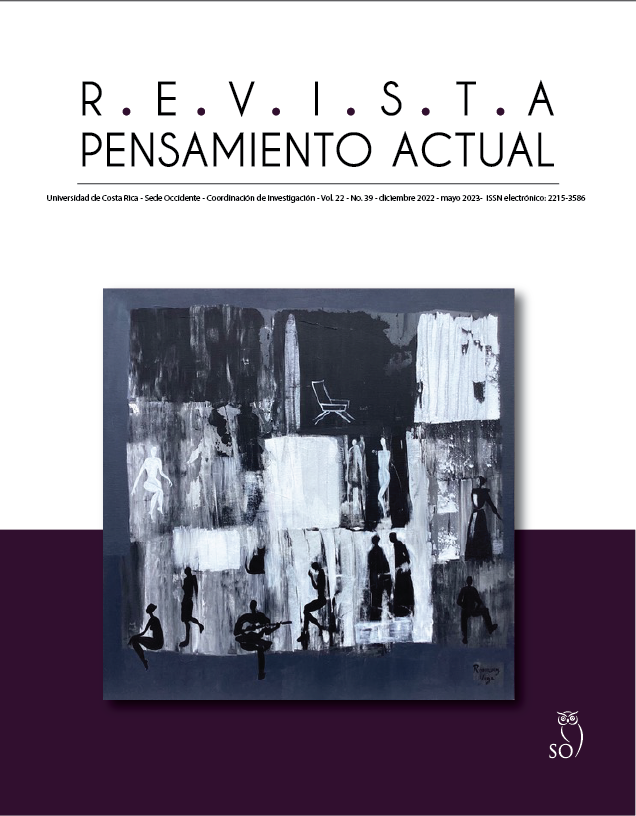Abstract
Carlos Salazar Herrera’s tales have been studied academically from different theoretical approaches. However, there is still no research that analyzes the presence of plant motifs and their narrative functions in the texts of this Costa Rican writer. Thus, the objectives of this article are (i) to give a detailed account of the plant motifs present in Cuentos de angustias y paisajes (1990), and (ii) to characterize the narrative functions that these motifs have in fifteen of the thirty tales included in this book (“El puente”, “El bongo”, “Un matoneado”, “El grillo”, “El beso”, “Un grito”, “Los colores”, “La sequía”, “El temporal”, “El estero”, “El curandero”, “La montaña”, “El chilamate”, “Una noche”, and “El resuello”). In total, 295 explicit references to the plant world were found in the work of Salazar Herrera (i. e. common names of plants, vegetation in general, organs and parts of plants, edible fruits and products of plant origin). In the texts analyzed, these motifs entail three types of narrative functions: setting the scene (setting function), introducing reading keys (hermeneutical function), and helping to build the multidimensionality of the characters, based on comparisons (rhetorical function). It is concluded that Salazar Herrera’s tales have a deep human meaning, since they explore the complexity of the relationships of the human being with its environment, with others and with itself, however, plant motifs of different kinds are used to elaborate the plot of that complexity.
References
Aristóteles. (1974). Poética. (Trad. Valentín García Yebra). Editorial Gredos.
Barthes, R. (1966). Introducción al análisis estructural de los relatos. En S. Niccolini (Comp.), Análisis estructural del relato (pp. 9-43). Tiempo Contemporáneo.
Bataille, G. (1970). Breve historia del erotismo. Ediciones Calden.
Bolaños, B. y González, G. (2010). Espacio rural e identidad nacional en los audiovisuales hechos a partir de la obra literaria de Carlos Salazar Herrera. Revista Comunicación, 19(2), 43-51.
Cirlot, J. (1992). Diccionario de símbolos. Editorial Labor.
Chevalier, J. (1986). Diccionario de los símbolos. Herder.
Fonseca, V. (2019). La paisajización de la mujer en Agustín Lara. Cuadernos Inter.c.a.mbio sobre Centroamérica y el Caribe, 16(1), e36457. https://doi.org/10.15517/c.a.v16i1.36457
Genette, G. (1982/1989). Palimpsestos: la literatura en segundo grado. Taurus.
Herrera Ávila, T. (2005). El incesante canto del grillo (duelo y angustia en Salazar Herrera). Filología y Lingüística, 31(extraordinario), 79-88.
Herrera Ávila, T. (2019). Espacio y angustia en Cuentos de angustias y paisajes de Salazar Herrera [Tesis de maestría, Universidad de Costa Rica]. Repositorio Institucional de la Universidad de Costa Rica, Kérwá. https://hdl.handle.net/10669/80470
Jones, S. (2005). El lexema “angustia” en un corpus de la literatura costarricense. Filología y Lingüística, 31(1), 51-56.
León, J., y Poveda, L. (1999). Los nombres comunes de las plantas en Costa Rica. Editorial Fundación UNA.
León , E. (2010). Estudio de la traducción al inglés del léxico popular costarricense en textos pertenecientes al género literario realista a la luz del skopos del texto meta. [Tesis de maestría, Universidad Nacional de Costa Rica]. Repositorio Académico Institucional de la Universidad Nacional de Costa Rica. http://hdl.handle.net/11056/15111
Lotman, I. (2002). El símbolo en el sistema de la cultura. Forma y función, 15, 89-101.
Morales, C. (2020). Origen, historia natural y usos de las plantas introducidas en Costa Rica. UNED Research Journal, 12(2), e3098. https://doi.org/10.22458/urj.v12i2.3098
Orias, E., y Quesada, M. (2018). “El puente” de Carlos Salazar Herrera: La línea entre el ser (civilización) y el no ser (naturaleza). Revista Estudios, Especial: Naturaleza amena y naturaleza agreste en las letras hispánicas, 1-23.
Ovares, F. (2006). Los linderos de la pasión: Cuentos de angustias y paisajes, de Carlos Salazar Herrera. Hipertexto, 3, 47-55.
Pravisani, C. (2019). Taxidermia del cuento. URUK editores.
Rodríguez, O. (2007). El miedo: rasgo identitario en Cuentos de angustias y paisajes, de Carlos Salazar Herrera, y en Urbanoscopio, de Fernando Contreras Castro. Káñina, Revista de Artes y Letras, 31(2), 237-243.
Salazar, C. (1990). Cuentos de angustias y paisajes. Editorial El Bongo.
Zamora, N. (2010). Vachellia. En B. E. Hammel, M. H. Grayum, C. Herrera, y N. Zamora (Eds.), Manual de plantas de Costa Rica (Vol. 5, pp. 748-752). St. Louis, Missouri, Missouri Botanical Garden / Instituto Nacional de Biodiversidad / Museo Nacional de Costa Rica.
Comments

This work is licensed under a Creative Commons Attribution-NonCommercial-ShareAlike 3.0 Unported License.
Copyright (c) 2022 Pensamiento Actual

